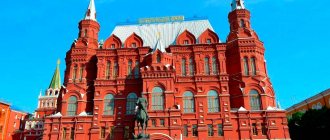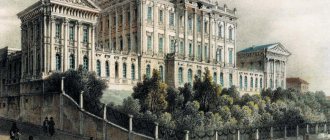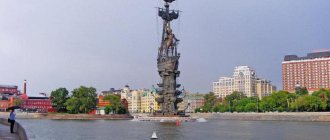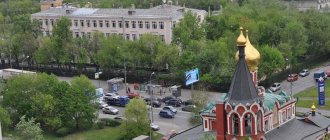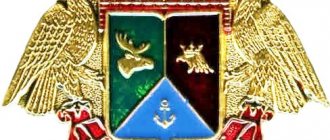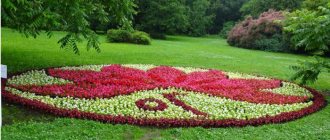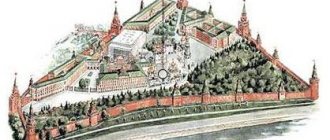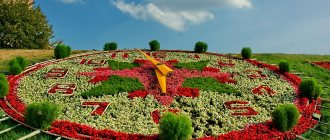Russia is a multinational and multicultural country. This is expressed in a large number of Orthodox churches, Jewish synagogues, Catholic cathedrals, and, of course, Muslim mosques. There are four large mosques in Moscow: the Moscow Cathedral Mosque, the Historical Mosque, the Memorial Mosque, as well as the complex of Inam and Yardyam mosques in Otradnoye.
Among my non-Moscow friends there are also several Muslims, and upon arrival in the capital they visit Muslim shrines. Therefore, I will tell you in more detail about each of the main mosques of the capital.
Construction stages
It is now unknown exactly when the mosque appeared in Zamoskvorechye. It is only known that from the beginning of the 19th century, Muslims in Moscow sought permission to build a mosque. At this time they occupied the building of the Mohammedan prayer house.
I wonder when the Moscow historical mosque was built?
In 1823, the capital's governor-general gave permission to build a temple made of stone. However, the long-awaited agreement was accompanied by a number of strict requirements:
- the presence of an azan - an invitation to prayer - was not allowed;
- the architectural form of the building should not resemble a mosque;
- the constructed building could not be called a mosque.
For construction, the authorities allocated a plot of land on the property of the merchant Khoshalov. Nowadays this is Bolshaya Tatarskaya Street in Moscow. 1823 was the date of foundation of the mosque.
First mosque
More than a hundred years ago, there was a mosque on the site of the current luxurious building. The Moscow Cathedral Church was erected in 1904. The building will be built according to the design of the Moscow architect Nikolai Zhukov, mainly at the expense of the famous philanthropist, merchant Salikh Erzin. This mosque became the second Muslim temple in the capital, but after the mosque in Zamoskvorechye was closed (in 1937), the address Vypolzov Lane, building 7, became a symbol of Soviet Islam.
The temple received a safe conduct from Stalin himself, which was a telegram of gratitude for helping the front during the Second World War. In addition, the visits of famous leaders of Muslim states to Vypolzov Lane in the post-war years reliably protected the religious life of the temple.
Gamal Abdel Nasser, Sukarno, Muammar Gaddafi and other famous politicians who sought the favor of the leadership of the Soviet Union, during their visits to the capital, visited not only the Kremlin, but also stopped at some advanced enterprise, and without fail a mosque.
Architecture
At first, the architecture of the building did not resemble a mosque in any way, but rather resembled many other mansions. The building was later renovated (in 1858). And in 1882 the building was reconstructed. The project was prepared by the architect G. Ivnitsky. The reason for this was the request of the elder Salih Erzin, who said that the number of Moscow adherents of Islam had grown, and the old mosque could not accommodate everyone.
As a result, the former building was enlarged along the facade, and minarets were also built. Now the mosque could accommodate 1,500 people (instead of 300, as before).
What does the name mean?
The Moscow historical mosque in the 19th century had the status of a Cathedral. But later this status passed to another mosque - in Vypolzovoy Lane. Since the 90s of the 20th century, the mosque we are describing acquired the name Historical, which emphasizes its oldest origin. It is believed that this mosque is the heir to the Zamoskvoretsk Muslim temple of the 17th-18th centuries.
The functioning of the institution was carried out according to the laws of 1857, according to which only representatives of the highest clergy in mosques with the status of cathedrals could conduct worship. Therefore, the mosque began to be considered a cathedral.
In 1915, a stone madrasah building was erected next to the mosque. The construction was financed by Sadek Erzin. Today it is an administrative building.
Reconstruction
The prayer house acquired the appearance of a real Muslim mosque only in 1882. A petition to reconstruct the building was submitted to the authorities by the elders of the Tatar Muslim Prayer Society Agiev and Khairov-Devishev. The design of the new building was drawn up by the architect D. I. Pevnitsky. Permission for construction was given by Governor-General Prince V. A. Dolgoruky.
During the reconstruction, the Moscow historical mosque was expanded along the western and eastern facades. At the same time, minarets were erected above both extensions. The house of worship that existed before could not accommodate more than 300 people. In the new building, 1,500 Muslims could freely pray at the same time.
It was the Moscow historical mosque that was considered the Cathedral Mosque throughout the entire 19th century. Currently, this status is occupied by the building built in 1904 on Vypolzovoy Lane. Today the mosque, built in Tatarsky Lane, is called Al-Masjid at-Tarikhi in Tatar, which is translated into Russian as “historical”. In 1915, a stone madrasah building was added to it. Today it serves as an administrative building.
Imams
An imam is the spiritual authority in Islam who heads a mosque. He is also considered a consultant on topics of faith. The word “imam” itself is translated from Arabic as “the one who is in front” (meaning during prayer).
The imams of the Moscow historical mosque were:
- S. M. Askhanov - in 1826.
- R. Ageev - from 1833 to 1868
- Kh. Ageev - until 1913.
- A. Shamsutdinov - from 1913 to 1936.
In 1923-1925, M. Bigi (a public figure and Islamic theologian) taught the fundamental principles of Islamic teachings in the mosque.
Imams of the mosque
Among the imams who served in the mosque over the years, the following should be highlighted: Bedretdin Alimov (the first imam), Safu Alimovov, Abdulvadud Fattakhetdinov, Ismail Mushtaria, Akhmetzyan Mustafin Rizautdin Basyrov, Ravil Gainutdin, Rais Bilyalov, Ildar Alyautdinov.
Today there are six imams serving in the temple. Ildar Alyautdinov is the chief imam of the Moscow Cathedral Mosque. He is assisted by Mustafa Kütyukçü, Rais Bilyalov, Anas Sadretdinov, Islam Zaripov and Vais Bilyaletdinov, the oldest imam (30 years of service). In Soviet times, this was the only mosque in the city that did not stop working and regularly held services.
During the years of Soviet power
In 1936, the Moscow Historical Mosque was closed. The imam was accused of anti-Soviet activities, arrested and executed.
During the years of Soviet power, the following people worked in the building:
- printing shop;
- civil defense point;
- DOSAAF (public-state organization whose goal is the defense of the country);
- military registration and enlistment office
In the 40s of the 20th century, Muslims sought to return the mosque building, but to no avail. And in 1967, by order of the authorities, the minarets (towers from which all believers are called to prayer) were demolished near the building.
Transfer of the building to Muslims
At the end of the 80s, the leaders of the Tatar community again made attempts to return the complex of the Moscow historical mosque (a photo of it is presented in the article). In 1990, the building was given to the Muslim religious society. Its leader at that time was M. Velitov.
But the printing shop located in the mosque building, as well as residents of nearby houses, protested, so the transfer process had to be delayed.
The final transfer of the temple to Muslims occurred only in 1991. That same year, on October 17, the first namaz (the canonical prayer of Islam) was held there.
In 1992, the building was reconstructed. This process was financed by the Moscow Embassy of the Kingdom of Saudi Arabia.
When did the Moscow historical mosque open again? This happened in 1993. And in 1998 it experienced another restructuring.
Temple today
The imams of the mosque in our time are:
- Kh. F. Fekhretdinov.
- R. Sadekov.
- Saleh Seyfetdinov.
- Akhmetzhanov.
The muezzin (servant who calls for prayer) is Rais Khaneveev. He was born in 1959 in the village of Andreevka, Nizhny Novgorod region.
Since 2000, the “Historical Mosque” charity organization has been operating at the mosque. The areas of its activity are:
- charitable assistance to parishioners;
- giving fitr-sadaqa (alms);
- distribution of meat during Eid al-Adha;
- guardianship of shelters;
- sending literature to prisons;
- issuing food vouchers to Muslims in need.
The foundation also sponsors a prayer room in drug treatment hospital No. 17.
There is a madrasah attached to the mosque, where they study Islamic basics and Arabic. The madrasah is headed by Kh. F. Fekhretdinov. Studies are carried out in Russian and Tatar.
Inam and Yardyam
The complex of Inam and Yardyam mosques is located on a small square in Otradnoye in the Moscow Otradnoye district, where all the representations of traditional religions of Russia are located. It is also called Little Jerusalem or New Jerusalem .
The complex includes the chapel of the Holy Great Martyr Panteleimon the Healer, the Orthodox Church of St. Nicholas of Myra, the foundation stone of a Buddhist stupa, the Darkei Shalom synagogue (Ways of the World), an educational and administrative complex and two mosques under one roof - the Tatar Yardem (Yardem) and Azerbaijani Inam.
The Moscow Shiite Inam Mosque was opened in 1999 on the initiative of the first President of Azerbaijan Ayaz Niyazi oglu Mutalibov, and its name means “faith” in Azerbaijani. The Inam Mosque forms an important part of the spiritual heritage of Muslims.
The Sunni Yardam Mosque was opened in 1997. Its name is translated from Tatar as “help”. At the mosque there is an educational and administrative building, where students get acquainted with the basics of the Islamic faith and its history, and study the Tatar and Arabic languages.
The mosque also houses the Hilal Charitable Foundation, an educational center, a halal products store, and provides funeral services. For Muslim events, the mosque has a conference room and a Muslim cafe.
Address : Moscow, st. Khachaturyan, 8k1.
Metro : station "Otradnoe"
Website : https://maginur.ru
Phone for information: +7 499 903–60-88.
Imam : Zhalyaletdinov Marat Tagirovich.
Both Moscow mosques - Inam and Yardyam - can accommodate a total of about 3,000 people to attend Friday sermons and other services, and perform namaz.
Where is the Moscow historical mosque located?
As already mentioned, the mosque is located in Moscow on Bolshaya Tatarskaya Street, 28, building 1, 2. This is the very heart of the Tatar community of Zamoskvorechye.
You can get to it by metro; the nearest stations are Tretyakovskaya and Novokuznetskaya. If you go by car, you need to get to the Zamoskvorechye district, to Bolshaya Tatarskaya Street.
Imams of the mosque await believers every day from 10.30 to 19.00. No prior registration is required. Friday prayer is performed every Friday at 12.40. Any changes to the schedule will be posted on the mosque’s website.
Cathedral Mosque
The Moscow Cathedral Mosque is the main Muslim place in Moscow. It is one of the highest and largest in Russia and Europe. The capacity can reach 10,000 worshippers. The mosque is located in the Meshchansky district in Vypolzovoy Lane near Durova Street and Olympic Avenue next to the Olimpiysky sports complex.
Moscow Cathedral Mosque on Vypolzovoy Lane
The first building of the mosque was built in 1904; in 2011 it was demolished for the construction of a new one, which opened on September 23, 2015. Since 1996, the Council of Muftis of Russia and the residence of Mufti Ravil Gainutdin have been located in a separate building on the territory of the Moscow Cathedral Mosque.
The new cathedral mosque is a six-story main building in the Byzantine style with several different-sized minarets, turrets and domes. The height of the main dome, covered with gold leaf, is 46 meters, the diameter is 27 meters.
The two main minarets are 78 meters high, making the mosque the tallest in Russia, along with the Salavat Yulaev mosque under construction in Ufa. Their shape symbolizes the centuries-old friendship of the Russian peoples: the minarets are similar both to the towers of the Moscow Kremlin and to the Syuyumbike tower of the Kazan Kremlin.
The small minaret is located above the historical part of the complex; it is crowned with a crescent, preserved from the old building. The roof and turrets are painted bluish-green, like the first Moscow mosque. 12 kilograms of gold leaf were used to gild the dome and minarets - in this way, the designers made a reference to the image of golden-domed Moscow.
Three of the six floors are intended for worship. The main prayer hall is on the third floor. The small prayer hall, located in the left wing, repeats the appearance of the old mosque. The women's prayer hall is located on the top level and has a separate entrance.
The first floor is dedicated to technical rooms, there is also a room for ablution and a cloakroom; on the second floor there is a conference room with booths for simultaneous translation and the Museum of Islam. About 320 different wall and ceiling lamps were used for lighting.
The building has seven elevators, which makes the mosque accessible to people with disabilities; there are screens on the floors for video broadcasting of prayers. Traditional Tatar ornaments are used in the interior design of the mosque. The walls, ceilings and dome are painted with verses from the Koran from the inside.
Address : Moscow, Vypolzov lane, 7.
Metro : station "Peace Avenue".
Website : https://www.mihrab.ru
Phone for information: +7 (495) 681–49-04.
Imam : Ildar Alyautdinov
Anyone can visit the Moscow Cathedral Mosque - you don’t have to be a Muslim to do so. However, taking into account religious tradition, women must wear closed clothing and cover their hair with a scarf. Shoes are removed upon entering the mosque. In the temple you need to behave quietly, without disturbing people from praying.
